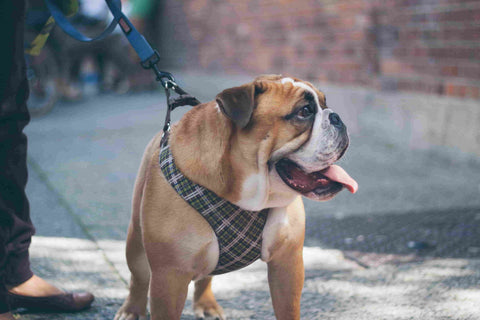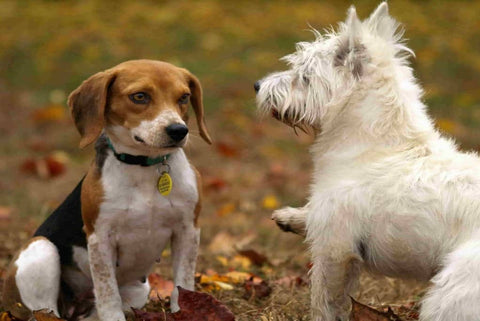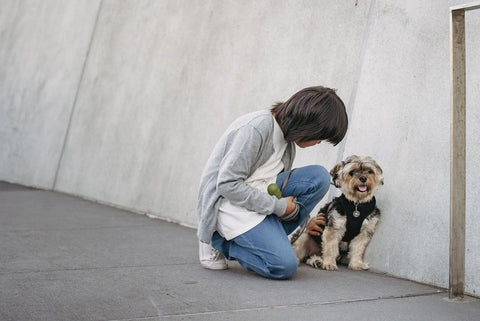Choosing the Right Size Dog Harness: All You Need to Know
A harness offers safety, control, and comfort, making it a perfect option for any dog. Using dog harnesses lowers the risk of injury, doesn’t concentrate pressure on the neck, and is a training tool.
With that in mind, getting the right size is going to help you maximize the benefits of a harness. Don’t make the mistake of guessing your dog’s size or even just relying on weight alone. Instead, follow our specific guidelines to measure your dog for a new harness and ensure the perfect fit.
How to Measure My Dog for a Harness
We’ve taken our extensive experience and put together a step-by-step guide to help you measure and get the right size dog harness. If you follow each step, you’ll find that perfect fit for comfort and ease of use.
- Step One: Use a soft measuring tape, and if you don’t have one, a ribbon or string with a ruler will work.
- Step Two: Have your dog stand as he normally would, with his weight evenly distributed and his back straight. You may need another person to help you with this.
- Step Three: Measure your dog’s girth, also known as chest circumference. Start at the ridge between the shoulder blades, and bring your measuring tape or string around the chest, directly behind the front legs, and back up to the shoulder blade point. When you’re measuring, the tape shouldn’t be tight, but it should be snug.
- Step Four: Use your tape measure or string to measure the circumference of the lower part of your dog’s neck, which is the thickest point. This is below where a collar typically sits.
- Step Five: Now take a length measurement, starting directly behind your dog’s front leg. Bring your tape measure to the point right behind the back leg.
- Step Six: Repeat your measurements at least once to ensure they’re accurate because dogs do tend to move around quite a bit.
- Step Seven: Compare your measurements to what’s listed on Pet&Cuddle’s size charts. If your dog’s on the upper end of a size, go up because you can always adjust the harness to fit more snugly.
- Step Eight: When your harness arrives, put it on and adjust it. Then, use the two-finger rule, meaning any two of your fingers should slide under the strap of the harness, but it shouldn’t be too loose or too tight when you do that. You can also try to pull the harness over your dog’s head, which you shouldn’t be able to do.
What Are the Major Dog Harness Features?
Size and fit are important, but they aren’t the only considerations when you’re choosing a new dog harness. The goal is to combine functionality and convenience with comfort and safety, so remember the following features.
1.) Safety: A safe harness design will protect your dog from injuries. You want one that’s not going to lead to tangling or put too much force or pressure on the neck. The no-choke feature is inherent in the design of a good-quality harness since it goes around the body rather than the throat.
2.) Easy to use: The goal is to walk your dog every day and maybe several times a day, so choose a harness that’s easy to get on and off.
3.) Adjustability: This concept goes back to the importance of a perfect fit. To customize the fit even more once you get the right size, look for adjustable belts. That will also give you more longevity because your harness can adjust with your dog’s changing needs.
4.) Weight: Don’t choose a heavy, cumbersome harness. That’ll make it a chore for you to take it with you. Choose a lightweight option that you can throw in a bag on the go without giving it a second thought.
5.) Clip location: There are three main options for clip location. There’s a back clip, which is good for well-trained dogs who don’t pull. Another option is a front clip, which can be used for training because it puts a bit of pressure on the shoulder blades if your dog tries to pull. The ideal type of harness is dual-clip, so you can use the top or back depending on your needs at that moment.
6.) Reflective details: Be safe if you walk early in the morning, in the evening, or any time visibility is low with reflective details.
7.) Material: Choose durable but also soft materials to keep your dog comfortable. Avoid rough materials that could irritate their skin or cause chaffing. The D-ring material should be metal because other weaker materials wear out faster.
Choosing a Dog Harness by Breed
Thinking about your dog’s breed can be part of choosing a harness, but a word of caution with these—even among the same breeds, there are still differences in overall size and structure. The breed is one component, but you also need to take your dog’s measurements.
Breeds that Fit a Small Harness
A small dog is one that has a chest girth between 17 and 22 inches. Most small dogs weigh between 18 and 35 pounds. Breeds that often wear a small size harness include:
- Cavalier King Charles
- Pekingese
- Miniature Schnauzer
- Pug
- Scottish Terrier
Breeds that Fit a Medium Harness
Medium-sized dogs tend to have a chest measurement of 22 to 27 inches and weigh 30 to 50 pounds. Dog breeds that could wear a medium harness are:
- Beagle
- Border Collie
- Boston Terrier
- English Bulldog
- French Bulldog
Breeds that Fit a Large Harness
With a chest girth of 27 to 32 inches, large breeds often weigh more than 45 pounds. Breeds that could fit comfortably in a large harness are:
- Boxer
- Dalmatian
- Golden Retriever
- Labrador Retriever
- Weimaraner
Why It's So Critical to Get the Right Size
To utilize the benefits of a harness, including safety, comfort, and control, you need a good fit. If a harness is too tight, you risk injuring your dog. It’s also uncomfortable, which could make him reluctant to want to walk. If you choose a harness that’s too big, it can get tangled or create an opportunity for escape. Getting one that’s too big can also make training a challenge.
Our designers at Pet&Cuddle have created a unique harness collection for your dogs, which is safe for the dog and can be used for training, leading, or adapting your pet for walking with a leash.
Discover the new collection of properly sized dog harnesses here.
Questions About Using Dog Harnesses
As leaders in dog harnesses and other safe and well-made equipment, we’re here to guide our customers. With that in mind, we also put together answers to some of the questions we most often get about using a dog harness to help as you’re making a decision.
What is a dog harness?
A harness is a pet accessory with a set of straps. They wrap around your dog’s body, and then you fasten them together. They’re a way to attach your dog to his leash with benefits including:
- Training: Dog harnesses make a good training tool, and they can be a way to teach a dog how to walk on a lead. There’s a reduced risk of getting tangled or injured during training.
- Control: If your dog pulls, is big, or you often walk in crowded areas, control is important. When you’re in control, you’ll feel mentally and physically more comfortable on walks.
- Pulling: This is in line with the training benefits of a harness. Dog harnesses discourage pulling by redirecting the effect to the chest and shoulder blades. It’s slightly uncomfortable, and it also teaches that pulling doesn’t get the dog anywhere.
- Safety: The pressure of a harness is dispersed around a dog’s body at multiple points, reducing the possibility of an injury.
Is a harness better than a collar?
In terms of safety, function, and comfort, a harness is an all-around better option than a collar. Consider how a collar is worn.
It’s only putting pressure right on your dog’s throat and neck. If he unexpectedly pulls, he can get injured. It’s also an uncomfortable way to train a dog on how to walk. A harness is a safer alternative. You also get more flexibility in how you use a harness compared to a collar.
Is It safe to use harnesses for a puppy?
Harnesses are a safe option for puppies, as long as it fits well and isn’t too loose. Most vets recommend waiting until your puppy is eight months old to start using a harness, but their advice may be different for you.
Can I Use a Retractable Leash with a Dog Harness?
Along with a harness, a retractable leash is one of our favorite dog accessories. Retractable leashes give you so many options as far as how you walk. If you’re in a crowded or congested area, keep your dog close to you, and then give him the chance to explore freely once you’re in a more open area.
Retractable leashes are absolutely safe to use with a dog harness, with a few key points in mind.
First, a retractable leash works best when you hook it to the back clip of the harness. Otherwise, if you use a retractable leash with the front clip, it’s confusing because your dog may feel like it’s pulling when it’s not. If you are going to use a retractable leash with a front clip, don’t let the leash generate any tension. That’ll reduce or eliminate pulling confusion.
Can a Dog Wear Harness 24/7?
While they have a lot of useful benefits, dog harnesses aren’t meant to be worn all the time. It can be uncomfortable to have the material rubbing against the skin or fur. Instead, establish a routine with your dog. When you take the harness out, your dog knows it’s time to go for a walk. When you get home, take it off again.
Get the Best Harness from Pet&Cuddle
To get the right harness for your dog, check the latest collections of Pet&Cuddle. Our dog harnesses are designed to provide maximum control, effective training features, and optimal safety for you and your dog.
Besides, our top-rated dog harnesses are comfortable and affordable, so there is always the best option you can choose for your pet. Our designers have created different sizes to ensure you can find the right harness for any breed.




